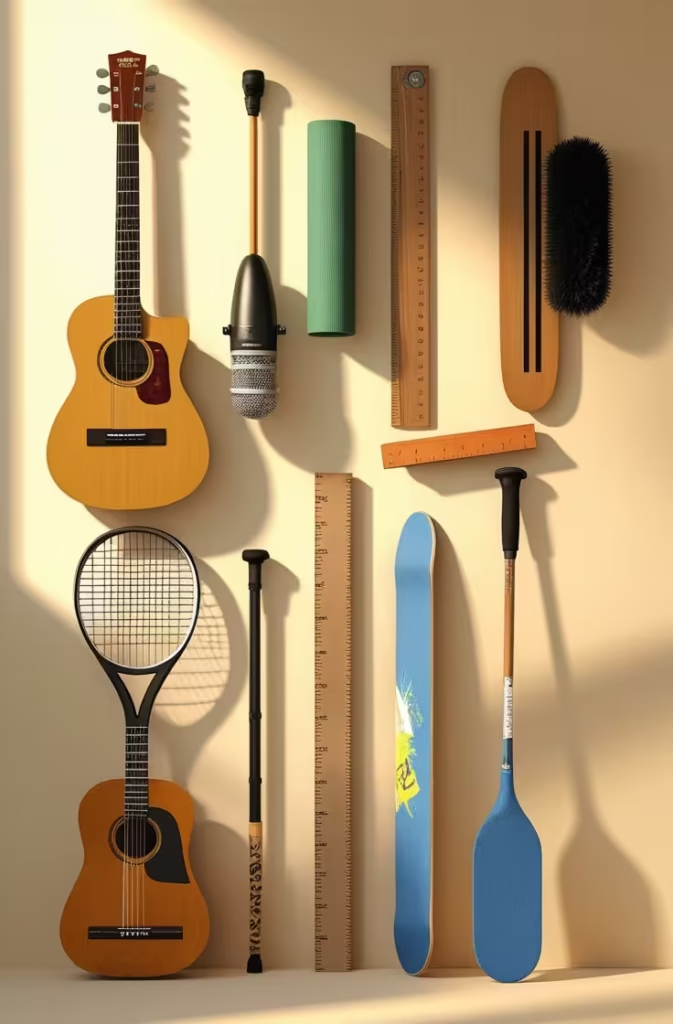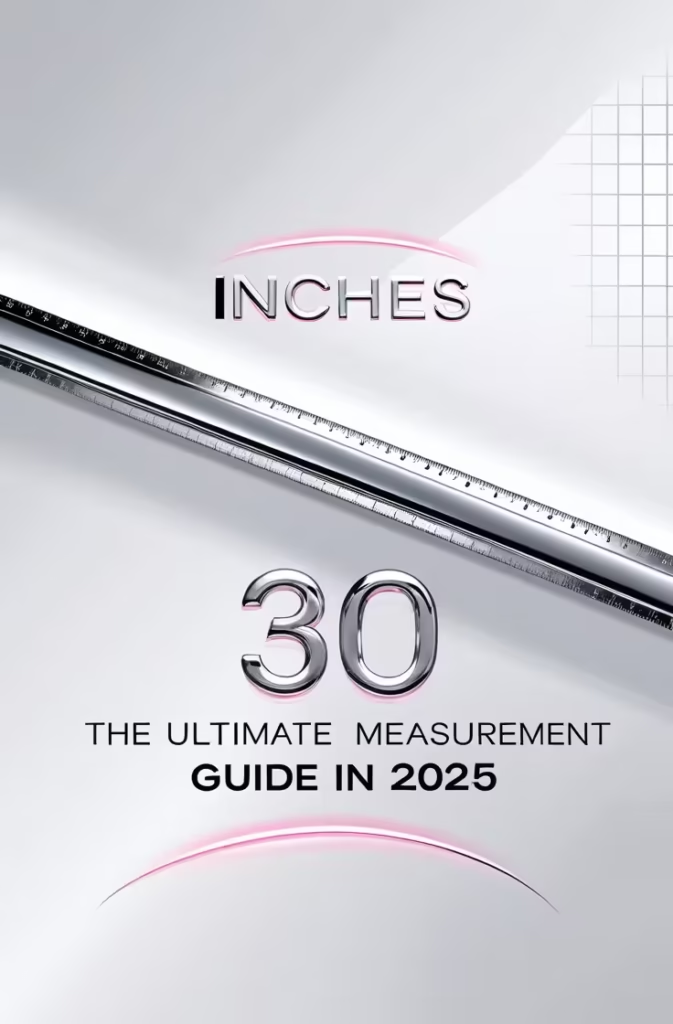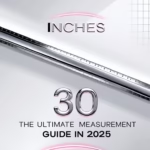Ever wondered how long 30 Inches actually is? Whether you’re decorating a room, building a shelf, or just trying to estimate the size of something, understanding the dimensions of 30 inches can help you make smarter decisions. It’s a common length that appears in furniture, tools, clothing, and even in nature.
In this guide, you’ll explore how to visualize, compare, and accurately measure 30 inches. We’ll dive into its use in design, construction, and pop culture—and even test your estimating skills. By the end, you’ll have a solid grasp of how much space 30 inches really covers.
What Does 30 Inches Look Like?

30 inches equals 2.5 feet or 76.2 centimeters. That might not sound like much, but in practical terms, it’s enough space to fit small furniture, stand a toddler upright, or span across a desk setup. You’ve probably interacted with this length more often than you think.
Imagine three standard 12-inch rulers laid end to end. That would measure 36 inches. Take off one of the rulers and you’re left with 24 inches. Add half a ruler back, and you’re now holding 30 inches. Visualizing this helps translate the measurement into real-world terms. You’ll start to recognize it all around your home or office.
30 Inches in cm Equasition and Example
To convert 30 inches into centimeters, you use the basic math formula: 1 inch = 2.54 cm. Multiply 30 inches by 2.54 and you get 76.2 cm. This formula is used worldwide when converting measurements between imperial and metric systems.
Let’s look at an example. If you’re planning to buy a 30-inch television, that diagonal size would equal 76.2 cm. This helps you confirm whether the TV fits on your entertainment center or wall mount, especially if product dimensions are listed in centimeters.
| Measurement Conversion | Value |
|---|---|
| 1 inch | 2.54 cm |
| 30 inches | 76.2 cm |
8 Common Objects That Are 30 Inches Long

Understanding 30 inches is easier when you compare it to real-life objects. Here are eight everyday items that are approximately 30 inches long:
- Baseball Bat
A standard baseball bat used by both amateur and professional players often measures exactly 30 inches. This size is suitable for youth leagues and some adult recreational players. It’s designed for easier handling, especially for younger players still learning the mechanics of the swing. A 30-inch bat offers a perfect balance between power and control, allowing players to hit with greater precision without sacrificing speed. - Guitar (Acoustic)
A guitar, specifically an acoustic one, usually has a body length of around 30 inches. This is typical for smaller body guitars often favored by beginners or children. With a shorter body, it can be more comfortable to play for those with smaller hands or shorter arms. Despite its compact size, a 30-inch acoustic guitar can still produce a rich, full sound, especially with careful craftsmanship in its design and construction. - Shower Curtain
A shower curtain from rod to hem is approximately 30 inches in length when half-draped. This dimension refers to how the curtain hangs when pulled across the width of your shower space. It’s a standard size used in many bathrooms, allowing the curtain to cover the entire length of the shower without pooling too much on the floor. It ensures privacy while minimizing water spillage outside the shower area. - Standard Poodle or Dalmatian
A standard poodle or a Dalmatian can be around 30 inches from chest to tail. These dog breeds are generally medium to large-sized, and their body length is typically measured from the tip of the nose to the tail’s end. This dimension gives you an idea of their size, with both breeds being well-known for their agility and distinctive appearances. A 30-inch measurement highlights their well-balanced physiques and ability to move swiftly. - Kitchen Counter Stool
A kitchen counter stool designed for a bar-height table often stands around 30 inches tall. This is the standard height for bar stools, designed to comfortably seat individuals at higher counters or kitchen islands. These stools are often made to be ergonomic and supportive, allowing people to sit comfortably while eating, cooking, or chatting at a bar or countertop. The 30-inch height provides the right elevation for optimal comfort. - Photography Light Stand
A photography light stand, when collapsed for storage, typically measures 30 inches. This portable piece of equipment is used to hold lighting fixtures for photographers or videographers. The 30-inch collapsed size makes it compact enough for easy transport while still offering adjustable height when fully extended. These stands are essential for achieving the right lighting angles in photography, whether in a studio or on-location shoot. - Bookshelf Shelf Width
A bookshelf shelf width is commonly 30 inches to hold a row of books. This size provides ample space for a collection of books or other items, making it a practical storage solution for any home or office. 30 inches is a standard width that ensures stability while maximizing the use of space. It allows for easy organization of books and other collectibles without overcrowding the shelf, providing a neat and tidy look. - Collapsed Tripod
A collapsed tripod used for cameras or lighting is often around 30 inches long. When not in use, a tripod folds down to a compact size for convenient storage and transport. The 30-inch collapsed length ensures the tripod remains portable, whether you’re a photographer, videographer, or content creator. This size allows for flexibility in setting up shots while maintaining an easy-to-carry setup, ideal for both outdoor and studio environments.
These objects help give you a tangible sense of how much space 30 inches really takes up in the real world.
How to Visualize 30 Inches Without a Ruler
If you don’t have a ruler or measuring tape, there are still clever ways to estimate 30 inches. Use your body as a guide. For most adults, the length from your elbow to your fingertip is roughly 15 inches. Double that, and you’ve got about 30 inches.
You can also use common household items. Five Bic pens end-to-end measure close to 30 inches. A legal-sized sheet of paper is about 14 inches long—two sheets laid out almost equal 30 inches. These visual tools are helpful when you need quick estimations without precise instruments.
30 Inches vs. Everyday Objects (Size Comparisons)
How does 30 inches compare to common household or personal items? Let’s start with doors. A standard interior doorway is usually 36 inches wide. Thirty inches would be narrower, but still large enough to walk through comfortably. It’s commonly used in closet or bathroom doors.
Think about a toddler aged 18–24 months. Many are around 30 inches tall, making that measurement relatable for parents. A 30-inch monitor is measured diagonally, so its width is less—usually around 26 inches. These comparisons make the dimension easier to grasp in your surroundings.
What Can You Build or Fit in 30 Inches?
A 30-inch space is enough to fit many pieces of furniture or appliances. You can build a 30-inch wide bookshelf or countertop with ease. It’s also a common width for kitchen base cabinets, giving you a great amount of storage without taking up too much room.
You can fit a small refrigerator, microwave stand, or even a guitar stand into 30 inches. In the garage, a 30-inch workbench offers plenty of surface area for small DIY projects. It’s also a comfortable width for a desk or a seating bench in your entryway.
The Science Behind the 30 Inches Measurement
The inch is part of the imperial measurement system, historically derived from human body parts, like the width of a thumb. Today, it’s standardized as 2.54 centimeters. This allows for accurate conversion and global consistency in manufacturing and engineering.
When engineers or architects use 30 inches in a design plan, it’s always calculated precisely to ensure compliance with building codes and ergonomic standards. This consistency matters in everything from designing cabinetry to configuring accessibility options in homes.
Fun Facts About 30 Inches
Did you know that a bowling lane approach area is roughly 30 inches wide at certain points to accommodate movement? Or that stacking three soda cans one on top of the other gives you nearly 30 inches? These fun facts make the dimension feel more approachable.
Another cool fact: 30 inches is the perfect width for most stairway steps in older homes. It allows people to move up and down safely while also saving space. It’s also the average width of a compact electric fireplace, often found in modern apartments.
30 Inches in Nature (Animals & Plants)

Nature also follows dimensions similar to ours. Many vegetable plants like cucumbers and tomatoes are spaced about 30 inches apart in gardens to give them room to grow. That layout helps gardeners optimize sunlight exposure and airflow.
Certain animals also match this size. A fox, from its nose to the tip of its tail, measures around 30 inches. Even birds like the pheasant or wild turkey are close to this length. These natural comparisons reveal how common this size is in the wild.
30 Inches in Design & Innovation
In interior design, 30 inches is a go-to measurement. A coffee table often stands 18 inches high but is 30 inches in length. That size allows for proper spacing and movement in living areas. Bookshelves and media stands are frequently made in 30-inch widths for symmetry and storage.
In technology, 30-inch monitors or television screens offer a balance between screen real estate and desk space. For professionals like graphic designers, that’s enough room for multitasking without overwhelming the workspace. It’s also a sweet spot for gaming setups.
Converting 30 Inches to Other Measurements
Understanding how 30 inches converts to other units of measurement can be incredibly useful for various applications. Here’s a comprehensive breakdown:
| Unit | Conversion |
|---|---|
| Centimeters | 76.2 cm |
| Millimeters | 762 mm |
| Feet | 2.5 feet |
| Meters | 0.762 meters |
| Yards | 0.833 yards |
This helps when reading blueprints, buying international products, or comparing metric vs imperial sizing. Being comfortable switching between units makes your work more accurate and globally relevant.
Tools to Measure 30 Inches Accurately
For precise measurement, always use the right tool. A tape measure is the most flexible and reliable method. It’s perfect for measuring curves, corners, and long straight lines. Yardsticks or meter sticks are rigid tools that also work well for straight surfaces.
If you’re working with smaller objects or need detailed precision, a digital caliper gives millimeter-level accuracy. Laser distance measurers are ideal for long-range use, like measuring a room. Using these tools ensures your 30-inch measurement is spot-on every time.
30 Inches in Movies, Memes, and Pop Culture
In pop culture, the phrase 30 inches often pops up for comedic or dramatic effect. It’s oddly specific and makes measurements seem more real or relatable. Memes exaggerate characters being “30 inches tall but full of rage,” turning size into humor.
In movies, especially those involving action or technology, a gadget or weapon may be described as 30 inches long to highlight its compact or massive design. Whether it’s a futuristic sword or a hidden compartment in a spy film, this length gives a sense of realism and scale.
Measurement Tips: Avoiding Common Mistakes
Many people mistake 30 centimeters for 30 inches. But they’re very different—30 inches is almost 76 cm, while 30 cm is under 12 inches. Always double-check the unit listed, especially in international manuals or furniture catalogs.
Also, remember that TV sizes are measured diagonally, not horizontally. A 30-inch screen might only be 26 inches wide, depending on the aspect ratio. When planning your space, use actual width and height dimensions—not just the
diagonal size—for accurate setup.
Quiz: Test Your 30 Inches Estimation Skills!
Which of the following items is closest to 30 inches in length?
A. A loaf of bread
B. A toddler’s height
C. A ballpoint pen
D. A gallon of milk
Answer: B. A toddler’s height
Most toddlers between 12 and 18 months old are about 28–32 inches tall, which is right around 30 inches. Try testing yourself at home with items like paper, bottles, or pet carriers. Estimating length is a useful life skill you can improve with practice.
Conclusion
Now that you’ve explored every aspect of 30 inches, you’ve got a practical understanding of what it looks like, how to measure it, and where it shows up in real life. From furniture and tech gadgets to animals and architecture, this measurement is everywhere.
Keep these comparisons and tips in mind during your next DIY project, furniture shopping trip, or even when you’re simply curious about size. Want to keep learning and mastering other measurements? Explore our full library of visual guides, comparison charts, and conversion tools.
FAQs
1. Is 30 inches considered tall or short?
It depends on context—short for a person, but tall for a table.
2. Can 30 inches fit through a doorway?
Most standard doors are at least 30–36 inches, so yes.
3. What’s the best use for a 30-inch shelf?
Books, electronics, or decor items.
4. How wide is a 30-inch cabinet?
Exactly 30 inches across, commonly used in kitchens and bathrooms.
5. What’s the diagonal of a 30-inch TV?
It’s 30 inches diagonally, not width-wise—width is around 26 inches.
6. How long is 30 inches in feet and inches?
2 feet and 6 inches.
7. Are all dogs around 30 inches long?
No, only medium to large breeds like Dalmatians or Huskies.
8. Is 30 inches a standard size for countertops?
Yes, especially in kitchen designs.
9. What’s a quick visual trick for 30 inches?
Use your forearm twice—it’s about 15 inches each.
10. How accurate is eyeballing 30 inches?
It depends on experience, but tools are always better for precision.

Aley Noraa is an experienced blogger with a passion for sharing insightful and engaging content. With years of writing under her belt, Aley combines her expertise in various topics with a unique voice that resonates with readers. Her dedication to delivering valuable information and inspiring stories makes her a standout author on Pursuit Hobby. When she’s not writing, Aley enjoys exploring new hobbies and connecting with her audience.







